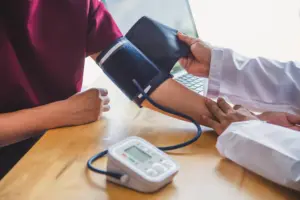
Blood pressure arm position: Have you ever had your blood pressure checked and wondered why the nurse or doctor told you to relax your arm or keep it at heart level? Well, you might be wondering what difference a few inches could make? Experts say even a few inches above or below heart level can significantly distort the result, risking false highs or lows, especially in people being monitored for hypertension.
What is hypertension?
Hypertension, or high blood pressure, occurs when the force of blood pressing against the artery walls stays too high over time. A normal blood pressure reading is usually around 120/80 mm Hg. If your numbers are consistently 130/80 mm Hg or even higher, that’s considered high blood pressure. Hypertension is often called the silent killer because it usually doesn’t cause noticeable symptoms, but silently harms vital organs like the heart, kidneys, brain, etc. Getting an accurate blood pressure reading and checking it regularly is the first step to protecting long-term health.
Also Read | High blood pressure in young adults: Causes, risks, and solutions
So why does arm position matter during blood pressure reading?
Your heart works like a pump, pushing blood through the body with measurable force. A blood pressure cuff is designed to record that pressure accurately, but only if your arm is positioned correctly. If your arm hangs below heart level, gravity adds extra force to the blood column. This action can make the cuff record an artificially higher reading, even if your true pressure is normal. If your arm rests above heart level, the opposite happens: gravity reduces the force, and the cuff may show a falsely lower reading. Even a small shift in arm position can alter the measurement by 10–15 mmHg, resulting in misdiagnosis or over-treatment.

The right way to position your arm during blood pressure reading
Firstly, you need to sit comfortably with your back straight and supported, keeping your feet flat on the floor, not crossed. Rest your arm on a table or pillow. Always keep your arm relaxed and supported at heart level during a reading to ensure accuracy. Don’t talk, text or move during the reading; just breathe normally and try to relax. Even small movements or holding your breath can impact the results.
Tips for a more accurate blood pressure reading
For the most reliable blood pressure measurement:
- Skip coffee, smoking, and exercise at least 30 minutes before.
- Empty your bladder to avoid false spikes.
- Sit quietly for 5 minutes to let your body settle.
Also Read | 7 myths about high blood pressure and the truth behind them
Managing hypertension is about getting the numbers right. Even minor details, like arm position, can shape treatment decisions and, ultimately, your health outcomes. Correct posture gives you more control over your health and ensures your doctor is working with accurate data.








